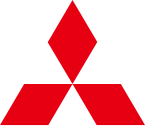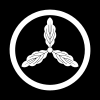Mitsubishi
| Mitsubishi (jap.
三菱 )
|
|
|---|---|
| legal form | economic group of independent companies ( Keiretsu ) |
| founding | 1870, as a group ( Zaibatsu ) |
| resolution | 1950, breakdown into loosely affiliated companies ( Keiretsu ) |
| Seat | Japan |
| Branch | Conglomerate : Vehicle construction, electrical engineering, chemistry, pharmacy, graphic industry, paper industry, real estate, heavy industry, finance, trade, mining, mining, etc. |
| Website | www.mitsubishi.com |
Mitsubishi ( Japanese 三菱 , based on the Japanese words “mitsu” and “hishi”, which literally means “three diamonds”) is a Japanese brand under which over two hundred different companies , groups , foundations and other organizations are networked (Japanese . keiretsu ). These emerged from the break-up of the Mitsubishi conglomerate (Japanese zaibatsu ) after the Second World War .
Although most of them operate under the Mitsubishi brand and use the Mitsubishi logo , they are legally independent of one another.
history
Before 1945
The company went from a 1857 at the invitation of the Tokugawa - shogunate by Dutchmen founded an iron foundry and shipyard in Dejima in Nagasaki forth. In 1868 the shipyard became state property. In 1870 Iwasaki Yatarō founded a shipping company with three rented steamers . The company name Mitsubishi was used from 1873. In 1884 he rented the shipyard from the state.
After Yatarō's early death in 1885, his younger brother Yanosuke took over management of the company. In the same year he founded Nihon Yūsen kaisha, a worldwide shipping line service. In 1887 he bought the Nagasaki shipyard under the name Nagasaki Shipyard & Machinery Works . Since 1891, the ship repair business was also operated in Yokohama . 1,914 were in Shimonoseki , the Mitsubishi Heavy Industries - Shimonoseki Shipyard & Machinery Works built. Yanosuke was also involved in mining and banking.
Mitsubishi, until 1945 always under the management of the Iwasaki family, became a corporate conglomerate of over 70 companies with business areas in banking , trade and real estate .
Mitsubishi was one of the leading arms manufacturers in Japan in the 1930s and 1940s . The Mitsubishi Aircraft Company manufactured the Mitsubishi A6M "Zero" fighter aircraft . By 1945 Mitsubishi had grown to over 200 companies.
After 1945
After the end of the Second World War, the Mitsubishi group, managed by a holding company, was broken up by the American occupation authorities into a number of companies that are independent of one another but continue to operate under the Mitsubishi logo and bear Mitsubishi as part of the company's name.
In 1964, essential parts of the company were merged again in Mitsubishi Heavy Industries , which today form the core of the company. In 1970 Mitsubishi Motors was spun off.
In 1992, the Mitsubishi Caterpillar Forklift joint venture was founded with Caterpillar to manufacture forklifts .
In 2005, the independent companies Mitsubishi Chemical Corporation and Mitsubishi Pharma Corporation merged to form Mitsubishi Chemical Holdings Corporation.
In 2012 Mitsubishi Heavy Industries and Hitachi decided to merge their thermal power plant business.
Mitsubishi builds rockets for the Japanese Space Agency that were used as carriers for navigation and weather satellites, regional aircraft as well as aircraft such as the Mitsubishi F-2 and tanks for the Japanese self-defense forces .
Company logo
Already in 1875 the ships of Iwasaki Yatarōs, the founder of Mitsubishi, sailed under a flag on which three diamonds arranged in a triangle were depicted. The logo was created from the family crest of the Iwasaki family (three diamonds) and the Yamanouchi family (three oak leaves), which are also part of the company .
Mitsubishi refers to the company logo and represents a combination of the words mitsu (three) and hishi ( diamond ). The word hishi actually means "water chestnut" , but also got the meaning "diamond" due to the shape of the water chestnut.
In German-speaking countries, the trademark is also known as the three Mitsubishi diamonds .
Mitsubishi principles
The fourth President of Mitsubishi, Koyata Iwasaki, defined three principles in the 1930s on which the company's actions should be oriented:
Shoki Hoko
( 所 期 奉公 , eng . Responsibility to society ) " Strive to enrich society both materially and spiritually while you contribute to the preservation of the global environment."
Doing business is a public endeavor and companies are responsible for promoting the vital interests of their host country. The entrepreneurial ideal for managers and employees must be participation in national prosperity. The ultimate purpose of any business is to contribute to the greater good of society.
Shoji Kōmei
( 処事 光明 , dt. Decency and justice ) " Maintain a corporate culture of transparency and openness, and conduct your business according to the principles of decency and justice."
Iwasaki repeatedly warned Mitsubishi executives not to focus only on numbers and lose sight of corporate ethics in competition. He urged managers and employees to respond to unscrupulousness with decency and to counter scams with honesty, reminding them that companies must meet the highest societal expectations for ethical behavior. That means doing more than just obeying the law. It means respecting the customs and sensibilities of every nation in which Mitsubishi operates.
Ritsugyō Bōeki
( 立業 貿易 , German: international understanding through trade ) " Expand your business based on an all-encompassing global perspective."
Two days after the outbreak of World War II, Iwasaki made a bold statement about friendship between business partners separated by war: “We count many British and Americans among our business partners. You did a lot of business with us. Should peace return, they should become good and loyal friends again. ”With“ Ritsugyō Bōeki ”, Iwasaki expresses the importance of an international perspective.
Mitsubishi company
The main companies that make up the Mitsubishi conglomerate are:
- Mitsubishi Motors (vehicle construction)
- Mitsubishi Fuso Truck and Bus Corporation (commercial vehicles)
- Mitsubishi Electric (electrical engineering)
- Mitsubishi Chemical (chemistry, Verbatim storage media)
- Mitsubishi Pharma (Pharmacy)
- Mitsubishi Paper-Mills (graphic industry, paper mill)
- Mitsubishi Estate (real estate)
- Mitsubishi Heavy Industries (heavy industry)
- Mitsubishi Trust and Banking (finance)
- Mitsubishi Corporation (trade)
- Nikon
- Bank of Tokyo-Mitsubishi UFJ
- Kirin Brewery (Brewery)
- Mitsubishi Materials (mining, coal and steel industry, metalworking tools)
- Tokio Marine Holdings (nonlife insurer)
- Mitsubishi Nichiyu Forklift (forklift, pallet truck and logistics solutions)
Motor sports activities
Due to the special requirements in motorsport , e.g. B. in relation to the required more flexible sales channels, in most countries a separate motorsport department takes over this business area. The Ralliart Group is responsible for this and is in turn its own organization in all countries.
Successes:
- FIA World Rally Championship: 1996, 1997, 1998, 1999
- Dakar Rally : 1985, 1992, 1993, 1997, 1998, 2001, 2002, 2003, 2004, 2005, 2006, 2007
- GT 300 Series (Team Taeivon Ralliart Mitsubishi FTO): 1998: 5th place / 1999: 6th place (driver: Akihiko Nakaya , Takahiko Hara , Ralph Firman )
Individual evidence
- ↑ Joint Ventures Planned. Chicago Tribune , March 29, 1992, accessed April 21, 2016 .
- ↑ company logo
- ↑ History - The three diamonds. In: mitsubishielectric.com - Factory Automation. Mitsubishi Electric Europe BV, accessed June 7, 2020 .
- ↑ Mitsubishi Principles


